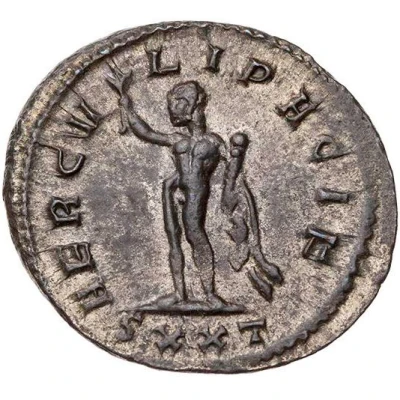


© Kölner Münzkabinett Tyll Kroha Nachfolger UG
Antoninianus - Probus ERCVLI HERCVLI PACIF; Hercules
| Silver | - | - |
| Issuer | Rome › Roman Empire (27 BC - 395 AD) |
|---|---|
| Emperor | Probus (Marcus Aurelius Probus) (276-282) |
| Type | Standard circulation coin |
| Years | 276-282 |
| Value | Antoninianus (1) |
| Currency | Antoninianus, Reform of Caracalla (AD 215 – 301) |
| Composition | Silver |
| Shape | Round (irregular) |
| Technique | Hammered |
| Orientation | Variable alignment ↺ |
| Demonetized | Yes |
| Updated | 2024-10-05 |
| Numista | N#292726 |
|---|---|
| Rarity index | 100% |
Reverse
Hercules, standing left, holding olive-branch in right hand and club and lion-skin in left hand.
Mintmark in exergue.
Script: Latin
Lettering:
ARCVLI PACIF or
AERCVLI PACIF or
ERCVLI PACIF or
HERCVLI PACIF
Unabridged legend: Herculi Pacificatori.
Translation: To Hercules, the peacemaker.
Comment
Source:Online Coins of the Roman Empire (OCRE)
Interesting fact
The Antoninianus coin was introduced by the Roman Emperor Caracalla in 215 AD as a replacement for the denarius, which had been the standard Roman currency for centuries. The Antoninianus was made of silver, but its value was not based on the value of the metal it was made of, but rather on its official value, which was set by the Roman government. This means that the Antoninianus was not a commodity-based currency, but a fiat currency, which is a currency that has no intrinsic value but is instead backed by the government's promise to accept it as payment for debts and taxes. The use of fiat currency was a significant innovation in the Roman Empire, as it allowed the government to finance its military campaigns and public works projects without having to rely on the limited supply of precious metals like gold and silver. However, the use of fiat currency also led to inflation, as the government could simply print more money to pay for its expenses, which reduced the value of the currency over time. Despite this, the Antoninianus remained an important part of the Roman economy for centuries, and its design and symbolism continue to be studied by historians and numismatists today.